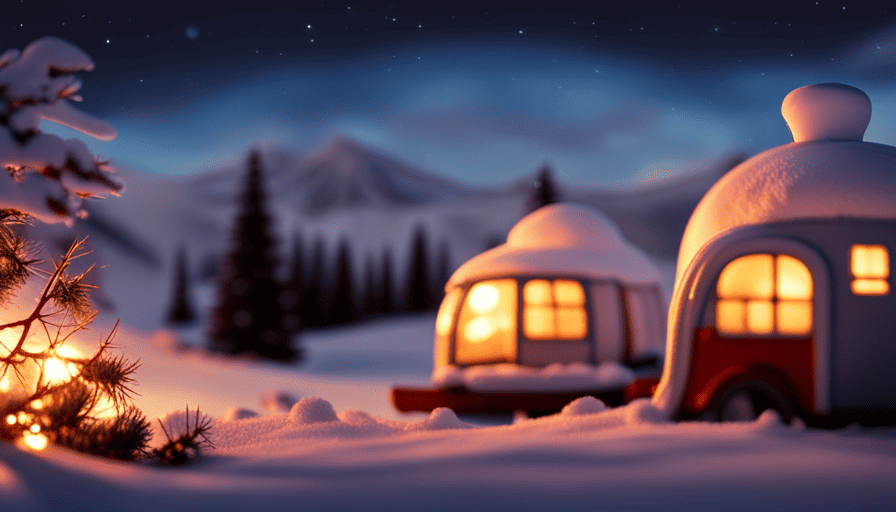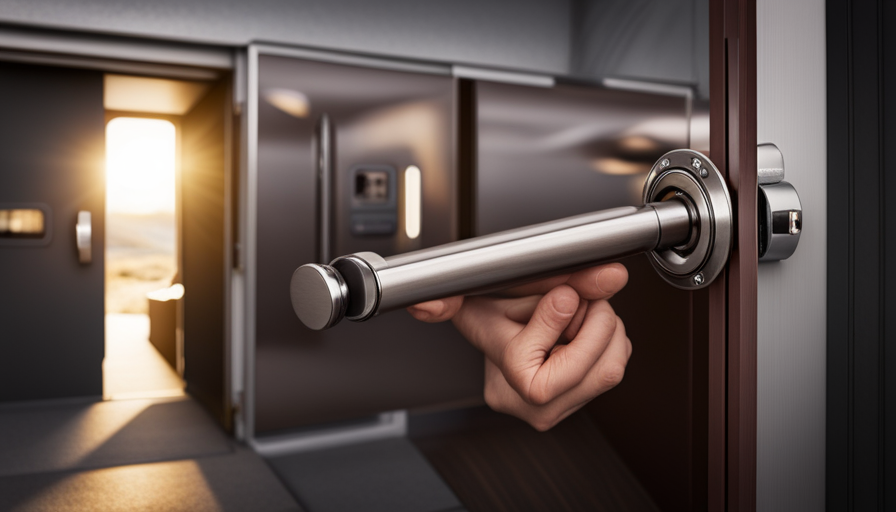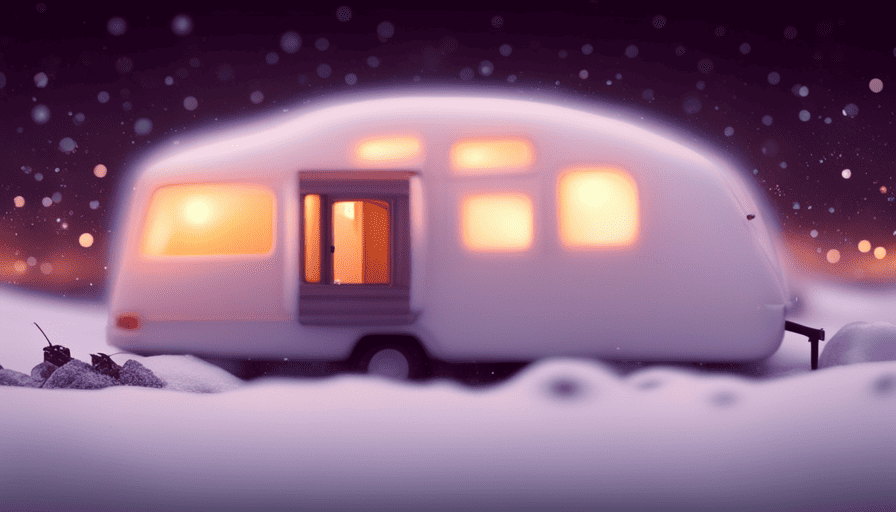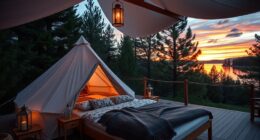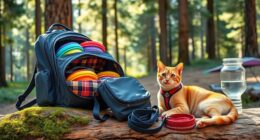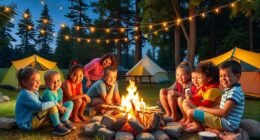Are you frustrated with pesky insects invading your camper and ruining your outdoor adventures? Don’t worry! In this article, I will share my effective strategies for keeping those annoying pests at bay.
From sealing cracks to using natural bug repellents, I’ve got you covered.
First and foremost, it’s crucial to seal any cracks and openings in your camper. Bugs can find even the tiniest gaps to squeeze through, so make sure to use sealant to keep them at bay. Additionally, installing screens on your windows and doors will provide an extra layer of protection.
Keeping your camper clean and free of food crumbs is another key step in bug prevention. Bugs are attracted to food, so regularly cleaning up and storing your food in sealed containers will help keep them away. You can also utilize natural bug repellents like citronella candles or essential oils to create a bug-free environment.
Furthermore, don’t forget to protect yourself! Using bug spray or insect repellent on your clothing and skin will help keep bugs from bothering you. Lastly, trimming vegetation and regularly inspecting and cleaning your camper will prevent bugs from nesting and making themselves at home.
With these practical tips and tricks, you can enjoy bug-free camping experiences and make the most out of your time in the great outdoors.
So, let’s dive in and learn how to keep those bugs out of your camper once and for all!
Key Takeaways
- Sealing cracks and openings in your camper is important to keep bugs out.
- Installing screens on windows and doors can prevent bugs from entering your camper.
- Regularly inspecting and cleaning your camper, as well as trimming vegetation, can help keep bugs away.
- Using natural bug repellents like citronella candles and essential oils can help repel bugs.
Seal any cracks and openings in your camper
Don’t let those pesky bugs ruin your camping trip – seal up any cracks and openings in your camper! Weatherproofing techniques for campers are essential to keep bugs out and maintain a comfortable environment. Luckily, there are plenty of DIY methods you can use to seal cracks and openings in your camper.
First, start by identifying any potential entry points for bugs. Inspect your camper thoroughly, paying close attention to windows, doors, vents, and utility openings. Once you locate the cracks and openings, it’s time to take action.
One effective technique is using weatherstripping. This adhesive strip can be applied to the edges of doors and windows, creating a tight seal. Additionally, you can use caulk to fill in any gaps around windows, doors, and utility openings. Be sure to choose a caulk specifically designed for outdoor use.
Another helpful tip is to use expandable foam insulation. This foam expands to fill gaps and cracks, providing an airtight seal. It’s perfect for sealing larger openings or gaps in walls and floors.
By using these DIY methods, you can effectively seal any cracks and openings in your camper, keeping bugs at bay.
Now, let’s move on to the next section about using screens on windows and doors.
Use screens on windows and doors
Screens on windows and doors are essential for enjoying the great outdoors while minimizing the risk of unwelcome visitors like mosquitoes, which are responsible for transmitting diseases to millions of people worldwide.
When it comes to window screen installation, make sure to measure your windows accurately to ensure a proper fit. It’s also important to choose screens with a fine mesh that can effectively keep out even the tiniest bugs. Additionally, consider using screens with UV protection to block harmful rays from entering your camper.
When selecting door screens, opt for ones that are durable and easy to install. Magnetic screens are a popular choice as they automatically close behind you, preventing bugs from sneaking in. Another option is retractable screens, which can be rolled up when not in use.
To keep your camper clean and free of food crumbs, be diligent about cleaning up after meals. Store food in sealed containers to prevent attracting bugs. Regularly empty and clean out your trash bins to avoid any lingering odors.
By following these tips, you can enjoy the great outdoors bug-free and transition into the next section about keeping your camper clean and free of food crumbs seamlessly.
Keep your camper clean and free of food crumbs
To maintain a pristine environment inside your camper, regularly sweep and wipe down surfaces, ensuring that no crumbs or food remnants are left behind. Preventing insect infestations is crucial in keeping bugs out of your camper. These pesky critters are attracted to food sources and can quickly turn your cozy retreat into an unwelcome infestation zone. By following effective cleaning methods, you can keep your camper bug-free.
One of the first steps in preventing insect infestations is to clean up any food crumbs or spills immediately. Use a broom or vacuum to sweep the floors, making sure to reach all the corners and crevices. Wipe down countertops, tables, and other surfaces with a disinfectant spray or a mixture of vinegar and water. Pay extra attention to areas where food is prepared or consumed.
In addition to regular cleaning, it’s important to store food in sealed containers. This prevents bugs from accessing your food supply and eliminates potential attractants. Use airtight containers or resealable bags to keep snacks, cereals, and other perishables secure. By implementing these simple practices, you can effectively prevent insect infestations in your camper.
Transitioning to the next section, it’s also essential to properly dispose of any trash or food waste to further discourage bugs from entering your camper.
Store food in sealed containers
Make sure you seal all your food in airtight containers to create a barrier against unwanted guests and maintain a clean and insect-free environment inside your camper. Storing food in sealed containers has numerous benefits, especially when camping. Here are three reasons why it’s important:
-
Preservation: Vacuum sealed containers help to extend the shelf life of your food by preventing air and moisture from reaching it. This means your food will stay fresh for longer periods, reducing the chances of attracting bugs.
-
Protection: Sealed containers act as a physical barrier, preventing bugs from accessing your food. This is especially important in a camper where space is limited, and any food left uncovered can quickly become a target for insects.
-
Organization: Using sealed containers helps to keep your camper tidy and organized. It allows you to stack and store food neatly, maximizing the available space and making it easier to locate specific items.
When it comes to natural bug repellents in a camper, there are alternatives to citronella candles. Some discussion ideas include using essential oils such as lavender or eucalyptus, which have insect-repelling properties. These oils can be applied to cotton balls and placed strategically around the camper to deter bugs. Additionally, installing screens on windows and keeping the camper well-ventilated can also help keep bugs at bay.
Transitioning into the next section, it’s important to explore the option of using natural bug repellents such as citronella candles or essential oils to further enhance the insect-free environment in your camper.
Use natural bug repellents such as citronella candles or essential oils
Utilizing natural bug repellents, such as citronella candles or essential oils, can effectively enhance the insect-free ambiance within your camper. When it comes to keeping bugs at bay, opting for natural bug repellent alternatives not only minimizes the use of harsh chemicals but also provides numerous benefits.
Essential oils, for instance, have long been used as bug repellents due to their strong scent that insects find repulsive. Citronella oil, derived from a type of grass, is particularly effective against mosquitoes, flies, and other flying insects. It emits a refreshing, lemony fragrance that acts as a natural deterrent. In addition to citronella, other essential oils like lavender, eucalyptus, and peppermint can also be used to repel bugs. These oils not only keep pests away, but they also add a pleasant aroma to your camper, creating a more enjoyable environment.
Furthermore, using essential oils as bug repellents is a safe option for both you and the environment, as they don’t contain harmful chemicals. Transitioning into the subsequent section about avoiding leaving lights on at night, it’s important to note that incorporating natural bug repellents in your camper is just one step towards creating a bug-free haven.
Avoid leaving lights on at night
Now that we’ve talked about using natural bug repellents like citronella candles and essential oils, let’s discuss another effective way to keep bugs out of your camper: avoiding leaving lights on at night.
This may seem like a simple tip, but it can make a big difference in keeping those pesky bugs away. Leaving lights on at night not only attracts bugs to your camper, but it also contributes to light pollution, which can have a negative impact on nocturnal wildlife.
Many insects are drawn to light sources, and when they gather around your camper, it can be quite a nuisance. By turning off unnecessary lights and using energy efficient lighting in outdoor spaces, you not only reduce the likelihood of bugs invading your camper, but you also help protect the natural habitats of nocturnal animals.
So, when you’re enjoying the evening in your camper, remember to turn off lights that aren’t needed. Opt for energy efficient lighting options, such as LED bulbs, to minimize the attraction to bugs.
By taking these simple steps, you can create a more bug-free and wildlife-friendly environment around your camper.
Speaking of bug prevention, let’s move on to the next tip: using bug spray or insect repellent on yourself and your clothing.
Use bug spray or insect repellent on yourself and your clothing
When you’re spending time outdoors in your camper, don’t forget to spray bug repellent on yourself and your clothing for added protection against those pesky critters. Bug spray or insect repellent is an essential tool to keep bugs at bay while camping. It provides numerous benefits that can make your camping experience more enjoyable and comfortable.
Firstly, bug spray acts as a barrier between you and the bugs, preventing them from landing on your skin and biting you. It repels mosquitoes, ticks, and other insects that can carry diseases such as West Nile virus or Lyme disease. By using bug spray, you can significantly reduce the risk of getting bitten and contracting these illnesses.
Secondly, there is a difference between bug spray and insect repellent. Bug spray typically contains chemicals like DEET or picaridin, which directly repel insects. On the other hand, insect repellent usually contains substances like citronella or eucalyptus oil, which mask the scents that attract bugs. Depending on your preferences and needs, you can choose the most suitable option for your camping trip.
To maximize the effectiveness of bug spray, it’s crucial to follow the instructions and reapply it as recommended. Additionally, wearing long sleeves, pants, and closed-toe shoes can further protect you from bug bites.
In the next section, we will discuss how to set up bug traps or sticky pads inside the camper to catch any bugs that manage to sneak in.
Set up bug traps or sticky pads inside the camper
To keep those pesky critters at bay while camping, it’s a great idea to set up bug traps or sticky pads inside your camper. Bug traps and sticky pads are effective tools for capturing and eliminating bugs that manage to find their way into your living space.
Here are three items you can use to create an effective bug trap setup:
-
Bug zapper: Hang a bug zapper near the entrance of your camper to attract and electrocute flying insects. This is particularly useful for mosquitoes and flies.
-
Sticky pads: Place sticky pads in areas where bugs are likely to crawl, such as corners, windowsills, and near any cracks or openings. The sticky surface of these pads will trap and immobilize bugs, preventing them from roaming around your camper.
-
Pheromone traps: Set up pheromone traps to lure and capture specific types of bugs, such as ants or pantry moths. These traps release a scent that attracts the insects, leading them to a sticky surface where they become trapped.
By setting up bug traps or sticky pads inside your camper, you can significantly reduce the number of bugs that enter your living space. However, it’s important to also take steps to keep vegetation and bushes trimmed around your campsite. This will help to further discourage bugs from gathering near your camper.
Keep vegetation and bushes trimmed around your campsite
Make sure to trim the vegetation and bushes around your campsite to prevent any unwanted critters from lurking near your cozy home on wheels. Maintaining a well-manicured campsite not only enhances the overall aesthetics but also serves as an effective bug deterrent. By eliminating overgrown vegetation and dense bushes, you are reducing the hiding spots and breeding grounds for bugs. To further emphasize the importance of this practice, let’s discuss a couple of ideas:
-
Proper disposal of waste: Bugs are attracted to food waste and garbage, so it’s crucial to dispose of any trash properly. Use sealed containers and make sure to empty them regularly to avoid attracting bugs.
-
Choosing a campsite away from standing water: Standing water is a breeding ground for mosquitoes and other insects. Select a campsite that is away from stagnant water sources such as ponds or puddles to reduce bug populations.
By implementing these strategies, you are taking proactive measures to keep bugs at bay. However, it’s essential to regularly inspect and clean your camper to prevent bugs from nesting inside. This ensures a bug-free environment for your camping adventures.
Regularly inspect and clean your camper to prevent bugs from nesting
Regularly inspecting and cleaning your camper ensures a bug-free environment, promoting a comfortable and enjoyable camping experience. To prevent bugs from nesting in your camper, it’s crucial to inspect the interior regularly.
Start by checking all the corners and crevices for any signs of insect activity. Look for droppings, webs, or eggs. Pay special attention to areas near windows, doors, and vents, as these’re common entry points for bugs. If you notice any signs of infestation, take immediate action by using insecticides or natural repellents.
Cleaning the exterior of your camper is equally important in keeping bugs at bay. Start by giving your camper a thorough wash using mild soap and water. Pay attention to areas where dirt, debris, or food particles can accumulate, such as the awning, tires, and storage compartments. Regularly sweep and vacuum the floors and upholstery inside your camper to remove crumbs and other attractants for bugs.
Additionally, it’s essential to keep your camper well-sealed. Check for any cracks or gaps in the walls, windows, and doors, and promptly repair them. Use weather stripping or caulking to seal any openings.
By maintaining a clean and well-inspected camper, you can create a bug-free environment and enjoy a hassle-free camping experience.
Frequently Asked Questions
How do I seal cracks and openings in my camper?
To seal cracks and openings in my camper, I use a combination of techniques that effectively prevent insect infestations.
First, I carefully inspect the camper for any visible cracks or gaps. Then, I use a high-quality sealant to fill in these openings, ensuring a tight seal.
Additionally, I reinforce vulnerable areas such as windows and doors with weather stripping.
By implementing these sealing techniques, I can confidently keep bugs out of my camper and enjoy a pest-free camping experience.
What types of screens should I use on my camper windows and doors?
When it comes to choosing screens for camper windows and doors, there are different types to consider, each with their own pros and cons.
One option is fiberglass screens, which are durable and resistant to tearing, but they can be more expensive.
Another option is aluminum screens, which are lightweight and affordable, but they may dent easily.
Lastly, there are pet-resistant screens, which are great if you have pets but they can be more expensive and less transparent.
How often should I clean my camper to keep it free of food crumbs?
I find that cleaning my camper at least once a week is an effective way to keep it free of food crumbs. However, the cleaning frequency may vary depending on individual circumstances such as the number of occupants and the amount of food consumed.
In addition to regular cleaning, I’ve found some alternative methods helpful in preventing food crumbs from attracting bugs. These methods include using sealed containers for food storage and wiping down surfaces after meals.
Can I use regular containers to store food in my camper, or do I need special sealed containers?
Sure, you can definitely use regular containers to store food in your camper. However, special sealed containers are highly recommended to keep bugs out. The airtight seal on these containers prevents any insects from getting inside and feasting on your food.
Additionally, using alternatives to traditional bug repellents, such as natural sprays or essential oils, can also help keep bugs away from your camper. It’s always better to be safe than sorry when it comes to protecting your food from unwanted visitors.
Are there any specific natural bug repellents that are more effective than others?
When it comes to natural bug repellents, there are a few options that have proven to be more effective than others. Citronella oil, for example, is known for its ability to repel insects such as mosquitoes and flies.
Another effective option is peppermint oil, which can deter ants, spiders, and even mice.
Lastly, lavender oil is great for keeping moths and mosquitoes at bay. It’s important to note that the effectiveness of these repellents can vary depending on the specific bug and the concentration of the oil used.
Are There Any Methods to Keep Squirrels and Bugs Out of the Camper?
Worried about pesky squirrels and bugs invading your camper? Fret not! There are effective methods to keep squirrels out camper. Seal any gaps or cracks, use airtight containers, store food properly, and keep the camper clean. For bugs, install screens on windows, avoid standing water, and use insect repellents.
Are Gnats and Other Bugs Commonly Found in Campers, and How Can I Keep Them Out?
Yes, gnats and other bugs are commonly found in campers, especially during the warm months. To get rid of gnats in campers, be sure to keep the interior clean and free of food crumbs and standing water. Sealing up any cracks and openings can also help keep these pests out.
Conclusion
In conclusion, by taking proactive measures to keep bugs out of your camper, you can ensure a peaceful and enjoyable camping experience. Imagine the tranquility of sitting inside your camper, surrounded by nature’s beauty, without the annoyance of buzzing insects.
With sealed cracks, screens on windows and doors, and a clean living space, you can create a bug-free sanctuary. Additionally, utilizing natural repellents, bug sprays, and traps will provide an extra layer of protection.
By regularly inspecting and maintaining your camper, you can prevent bugs from intruding and nesting. So gear up, follow these practical steps, and embark on bug-free camping adventures.


